The Room Temperature Multi-Channel Heterodyne Receiver Section of the PHAROS2 Phased Array Feed
Abstract
:1. Introduction
- A 4–8 GHz cryogenic section comprising an array of Vivaldi antennas cascaded with new LNAs with state-of-the-art performance (noise temperature Tn = 2.3 K typical);
- A 2.3–8.2 GHz room-temperature WS multi-channel receiver, described in this paper;
- An Italian tile processing module (iTPM) digital backend based on a field programmable gate array (FPGA) that is capable of digitizing and forming four independent beams across a ≈275 MHz IF band [12].
2. Design of Warm Section Multi-Channel Receiver
2.1. Eight-Channel Warm Section RF/IF Module
2.2. Local Oscillator Distribution Module
2.3. Warm Section Monitor and Control Module
3. WS Fabrication, Integration and Assembly
3.1. Eight-Channel Warm Section RF/IF Module
3.2. LO Distribution Module
3.3. Monitor and Control Module
3.4. Fully Assembled 32-Channel Receiver
4. WS Multi-Channel Receiver Characterization
- Without the IFoF optical links, by extracting the IF outputs from the on-board MCX IF connectors;
- Including the IFoF optical links, by extracting the IF after optical-to-IF conversion using the iTPM pre-ADUs digital backend.
4.1. Characterization of Eight-Channel WS RF/IF Modules without IFoF Links
- The MCX connector of channel 3 (brown curve, resulting in a channel 3 gain of order 13 dB);
- The MCX connector of channel 2 (blue curve).
4.2. Characterization of Eight-Channel WS RF/IF Modules with IFoF Links
5. Conclusions
Author Contributions
Funding
Acknowledgments
Conflicts of Interest
References
- Fisher, J.R.; Bradely, R.F. Full-sampling array feeds for radio telescopes. In Proceedings of the SPIE Astronomical Telescopes and Instrumentation, Munich, Germany, 3 July 2000. [Google Scholar]
- Warnick, K.; Maaskant, R.; Ivashina, M.V.; Davidson, D.B.; Jeffs, B.D. High-Sensitivity Phased Array Receivers for Radio Astronomy. Proc. IEEE 2016, 104, 607–622. [Google Scholar] [CrossRef]
- Anish Roshi, D.; Shillue, W.; Simon, B.; Warnick, K.F.; Jeffs, B.; Pisano, D.J.; Prestage, R.; White, S.; Fisher, J.R.; Morgan, M.; et al. Performance of a highly sensitive, 19-element, dual-polarization, cryogenic L-band phased array feed on the Green Bank Telescope. Astron. J. 2018, 155, 18. [Google Scholar]
- DeBoer, D.R.; Gough, R.G.; Bunton, J.D.; Cornwell, T.J.; Beresford, R.J.; Johnston, S.; Feain, I.J.; Schinckel, A.E.; Jackson, C.A.; Kesteven, M.J.; et al. Australian SKA Pathfinder: A High-Dynamic Range Wide-Field of View Survey Telescope. Proc. IEEE 2009, 97, 1507–1521. [Google Scholar] [CrossRef]
- Hut, B.; van den Brink, R.H.; van Cappellen, W.A. Status update on the system validation of APERITIF, the phased array feed system for the Westerbork synthesis radio telescope. In Proceedings of the 11th European Conference on Antenna and Propagation (EUCAP), Paris, France, 19–24 March 2017. [Google Scholar]
- Simons, J.; Ivashina, M.; Vaate, J.G.B.D.; Roddis, N. Beamformer system model of focal plane arrays in deep dish radio telescopes. In Proceedings of the European Microwave Conference, Paris, France, 4–6 October 2005; Volume 3, p. 4. [Google Scholar]
- Ciccognani, W.; Di Paolo, F.; Giannini, F.; Limiti, E.; Longhi, P.E.; Serino, A. A GaAs Front-end Receiver for Radio Astronomy Applications. In Proceedings of the 13th IEEE Melecon, Malaga, Spain, 16–19 May 2006. [Google Scholar]
- Liu, L.; Grainge, K. Realization of phased arrays for reflector observing systems. In Proceedings of the XXXIInd General Assembly and Scientific Symposium of the International Union of Radio Science (URSI GASS), Montreal, QC, Canada, 19–27 August 2017. [Google Scholar]
- Liu, L.; Grainge, K.; Navarrini, A. Analysis of Vivaldi array antenna for phased array feeds application. In Proceedings of the IEEE MTT-S International Conference on Numerical Electromagnetic and Multiphysics Modeling and Optimization for RF, Microwave, and Terahertz Applications (NEMO), Seville, Spain, 17–19 May 2017. [Google Scholar]
- Navarrini, A.; Monari, J.; Scalambra, A.; Melis, A.; Concu, R.; Naldi, G.; Maccaferri, A.; Cattani, A.; Ortu, P.; Roda, J.; et al. Design of PHAROS2 Phased Array Feed. In Proceedings of the 2nd URSI Atlantic Radio Science Meeting (AT-RASC), Gran Canaria, Spain, 28 May–1 June 2018. [Google Scholar]
- Van Ardenne, A.; Bregman, J.D.; van Cappellen, W.A.; Kant, G.W.; Bij de Vaate, J.G. Extending the Field of View with Phased Array Techniques: Results of European SKA Research. Proc. IEEE 2009, 97, 1531–1542. [Google Scholar] [CrossRef]
- Naldi, G.; Comoretto, G.; Chiello, R.; Pastore, S.; Pupillo, G.; Mattana, A.; Melis, A.; Concu, R.; Alderighi, M.; Aminaei, A.; et al. Development of a new digital signal processing platform for the Square Kilometer Array. In Proceedings of the 2nd URSI Atlantic Radio Science Meeting (AT-RASC), Gran Canaria, Spain, 28 May–1 June 2018. [Google Scholar]
- Vaz, B.; Verbruggen, B.; Erdmann, C.; Collins, D.; Mcgrath, J.; Boumaalif, A.; Cullen, E.; Walsh, D.; Morgado, A.; Mesadri, C.; et al. A 13Bit 5GS/S ADC with Time-Interleaved Chopping Calibration in 16NM FinFET. In Proceedings of the IEEE Symposium on VLSI Circuits, Honolulu, HI, USA, 18–22 June 2018. [Google Scholar]
- XILINX, An Adaptable Direct RF-Sampling Solution. WP489 (v1.1). Available online: https://www.xilinx.com/products/silicon-devices/soc/rfsoc.html (accessed on 20 February 2019).
- Rusticelli, S.; Perini, F. PHAROS2 Pre-ADU Acceptance Test Report; INAF-IRA Internal Report; INAF-Istituto di Radio Astronomia: Medicina, Italy, 2017. [Google Scholar]
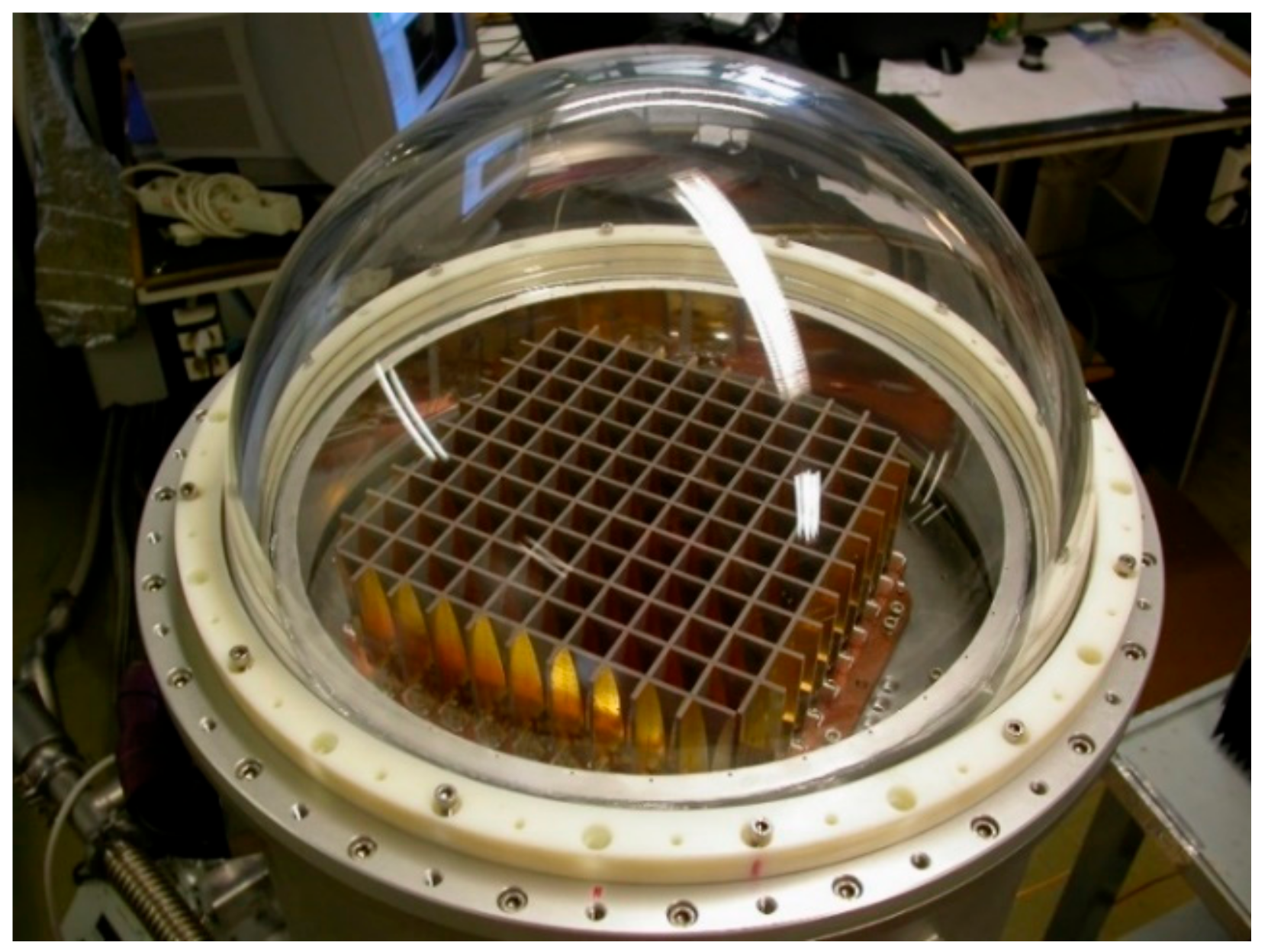
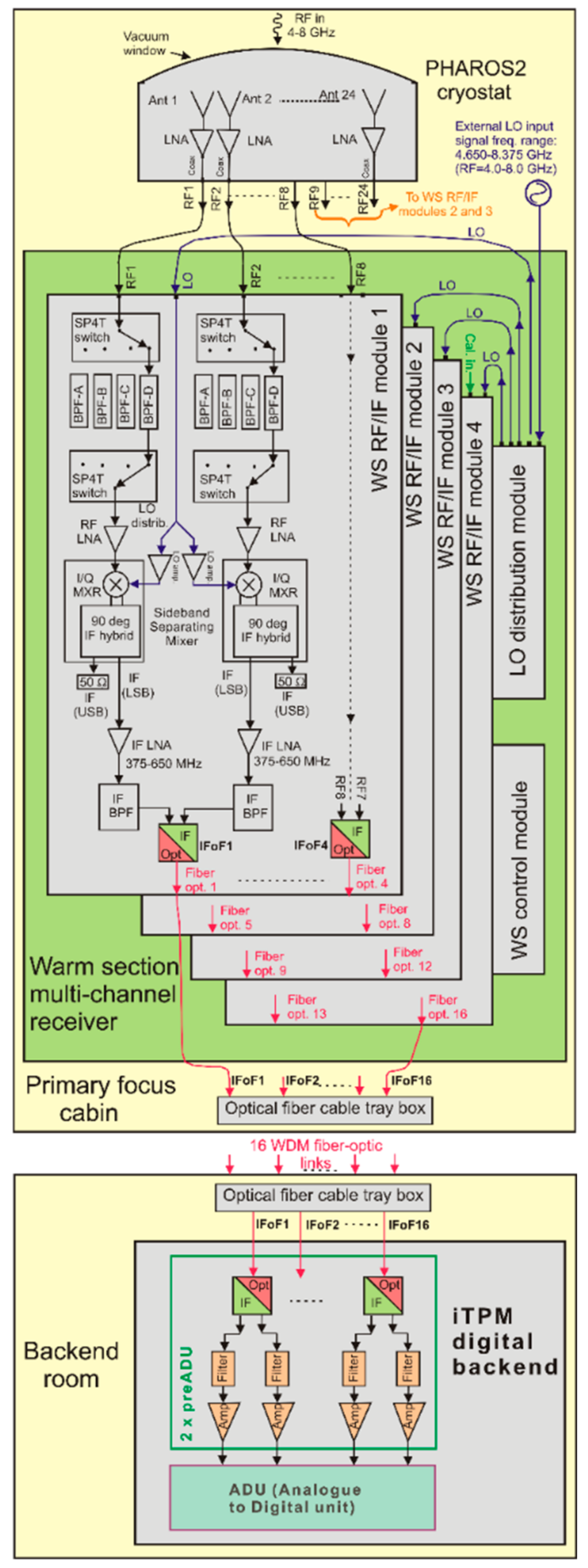
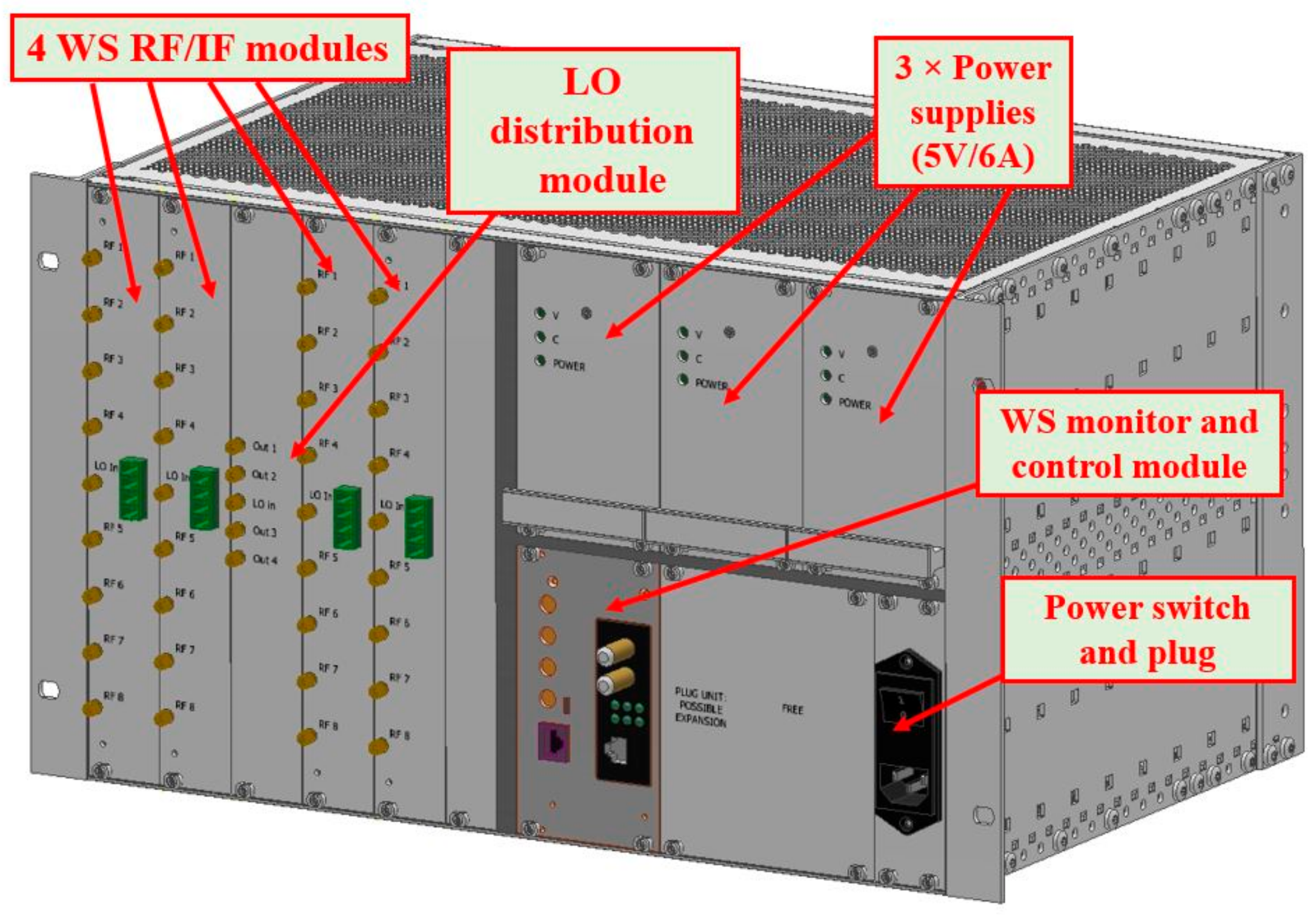
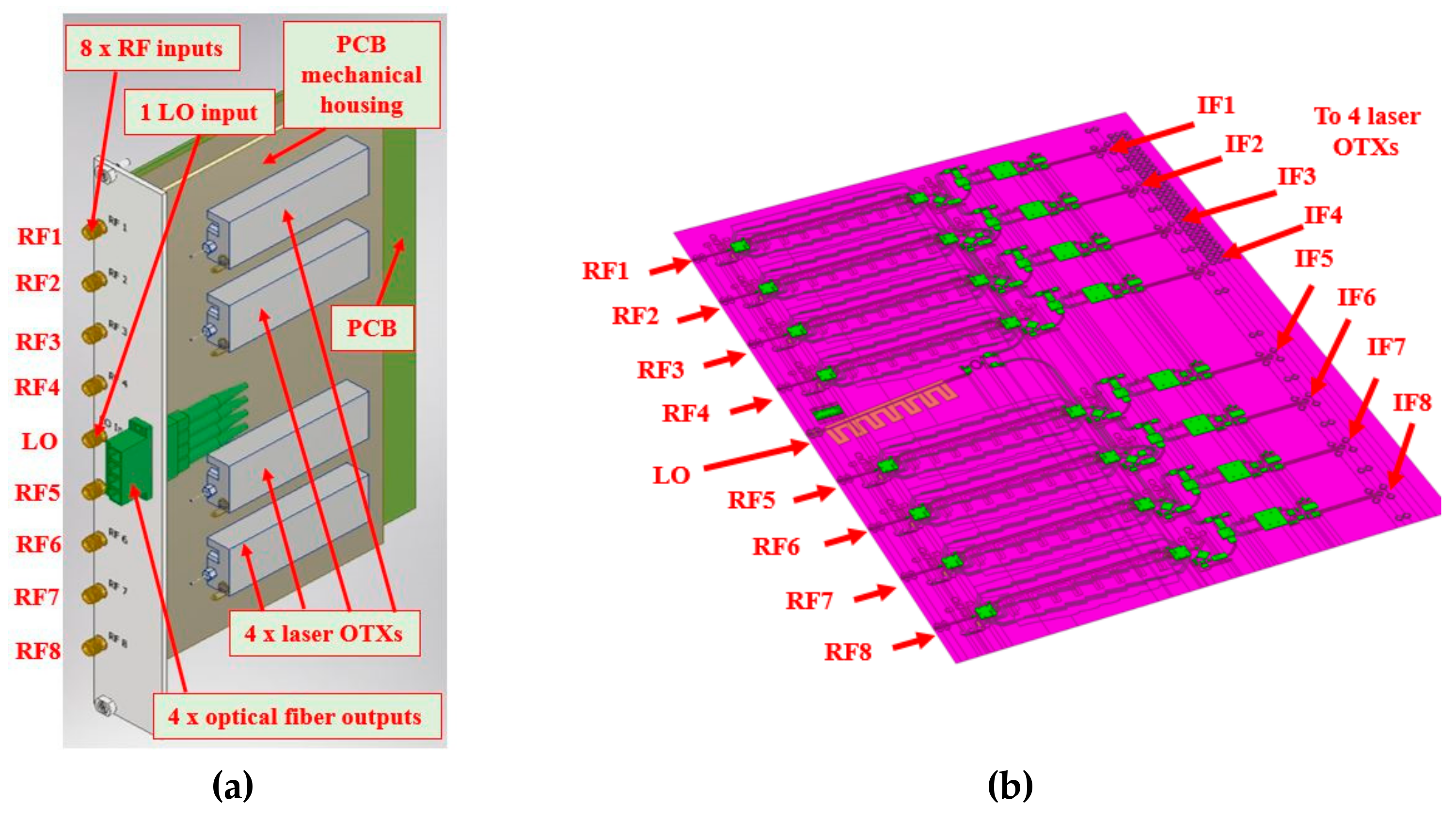
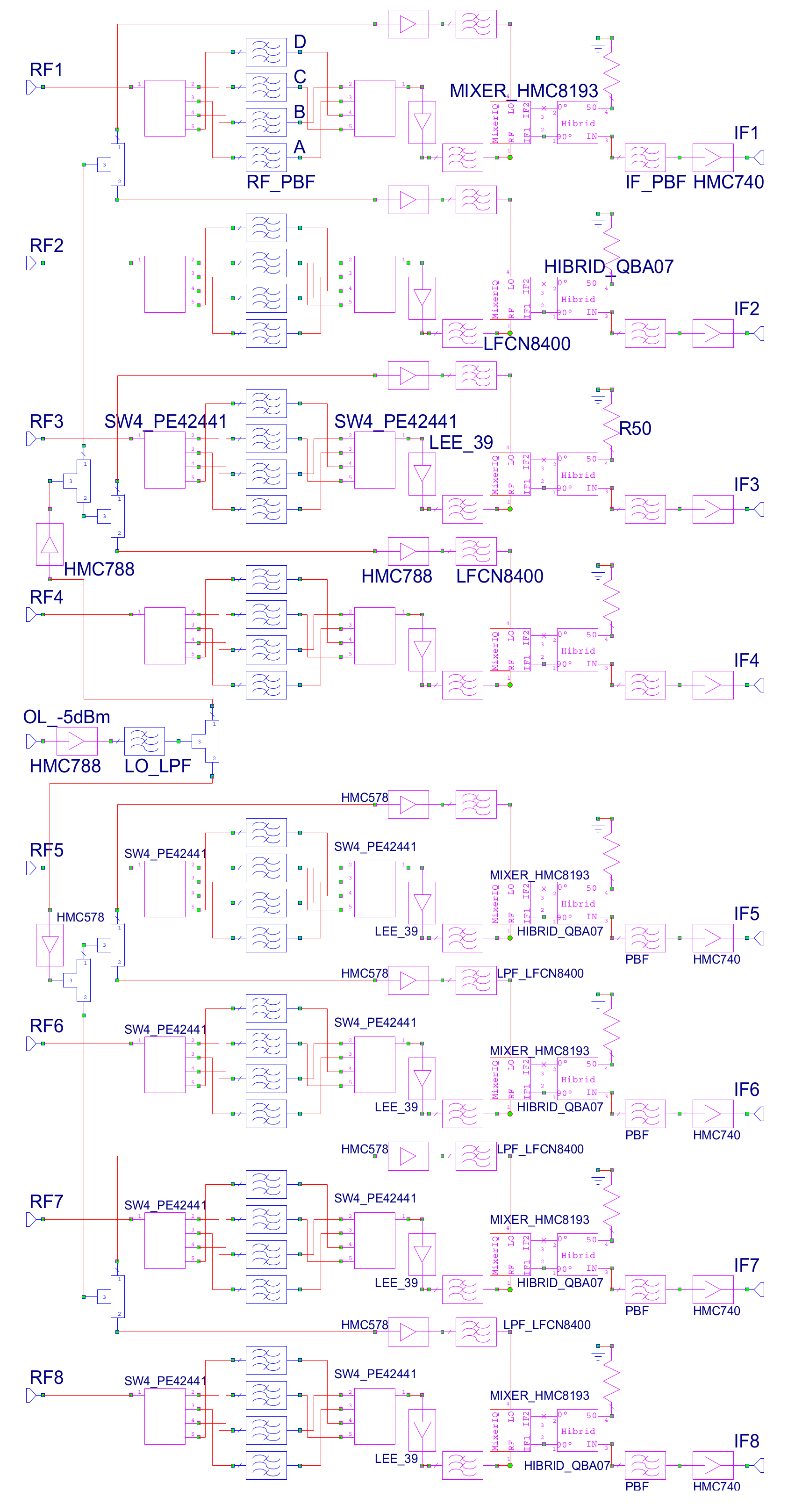
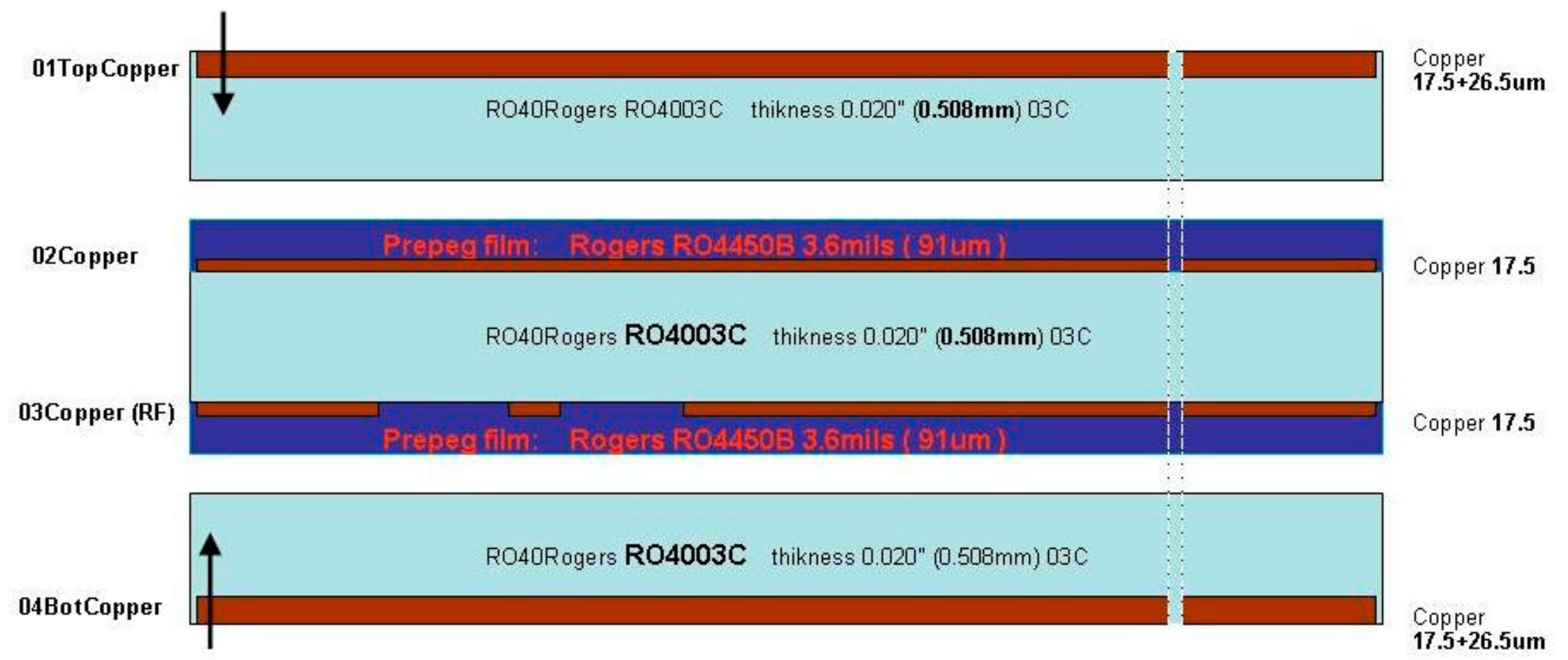
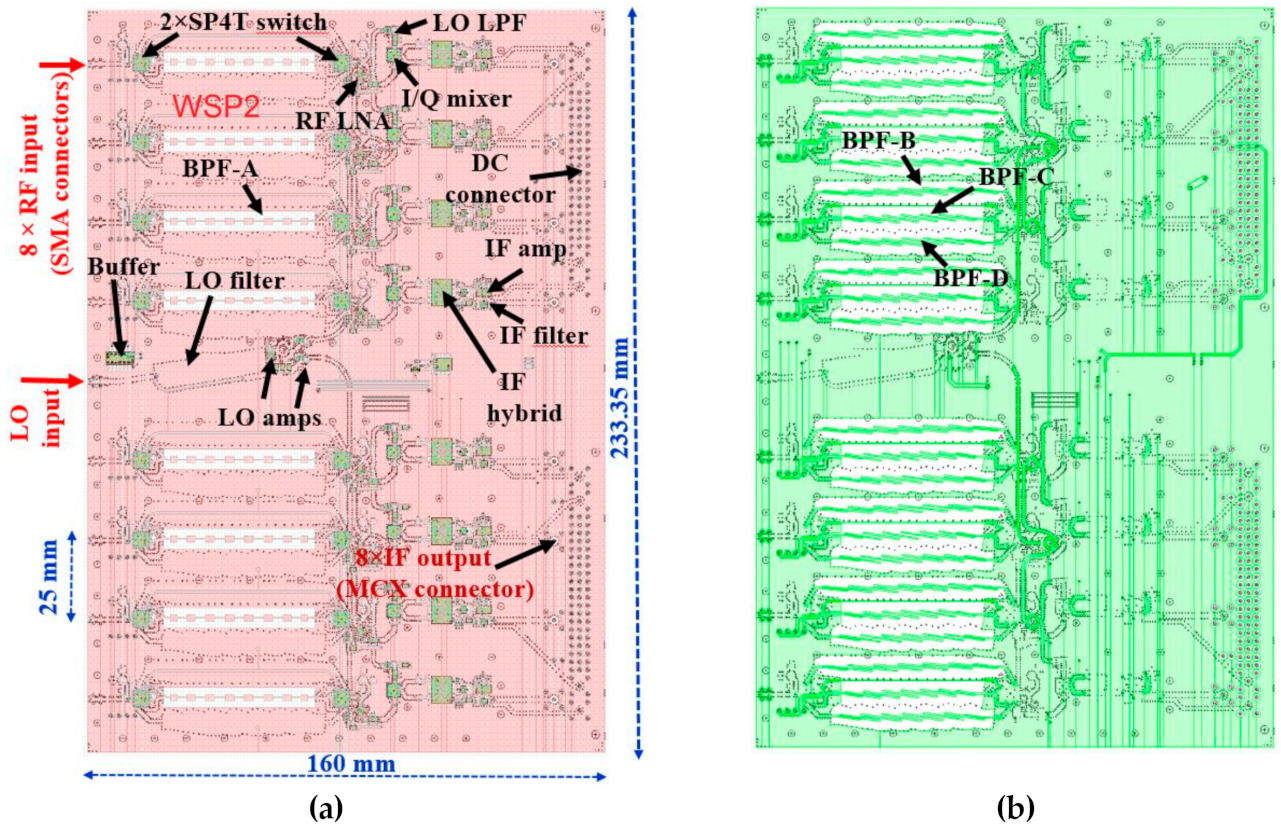

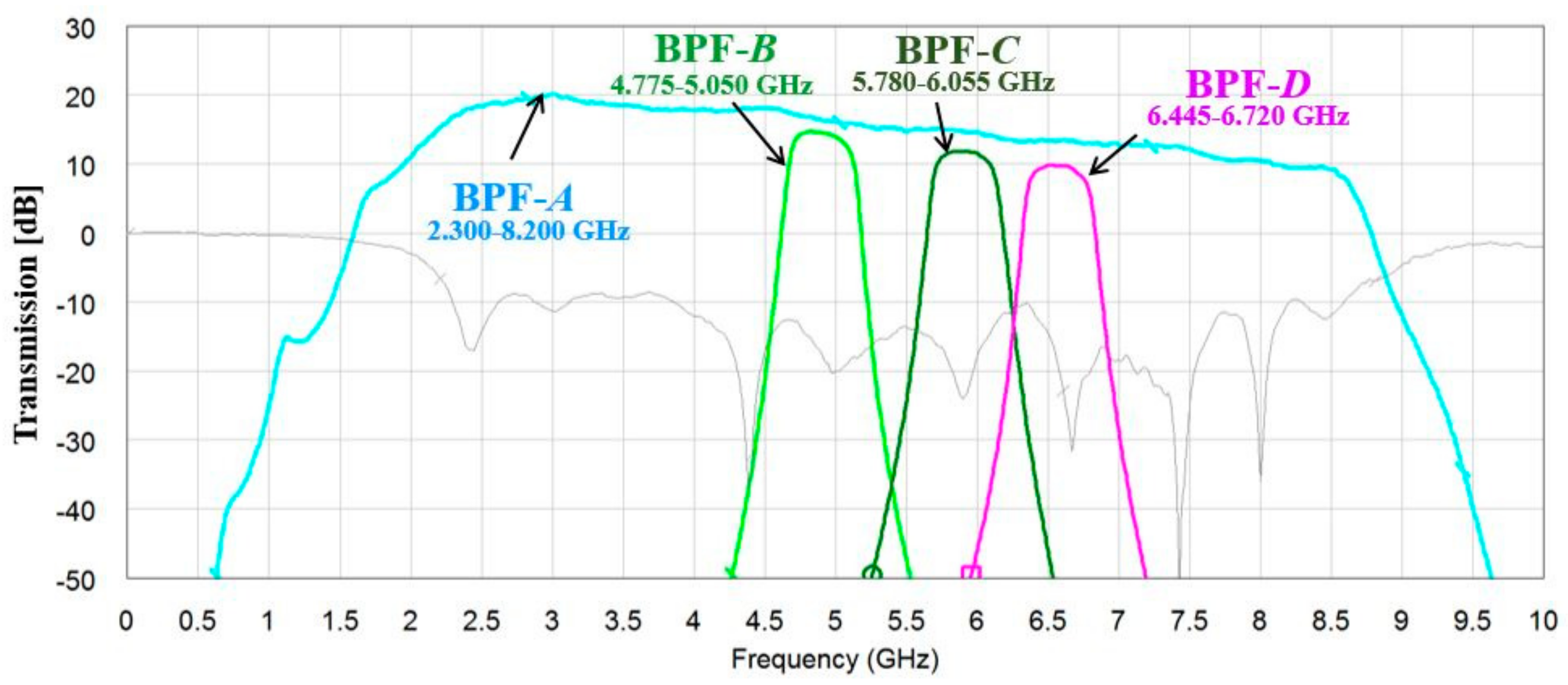
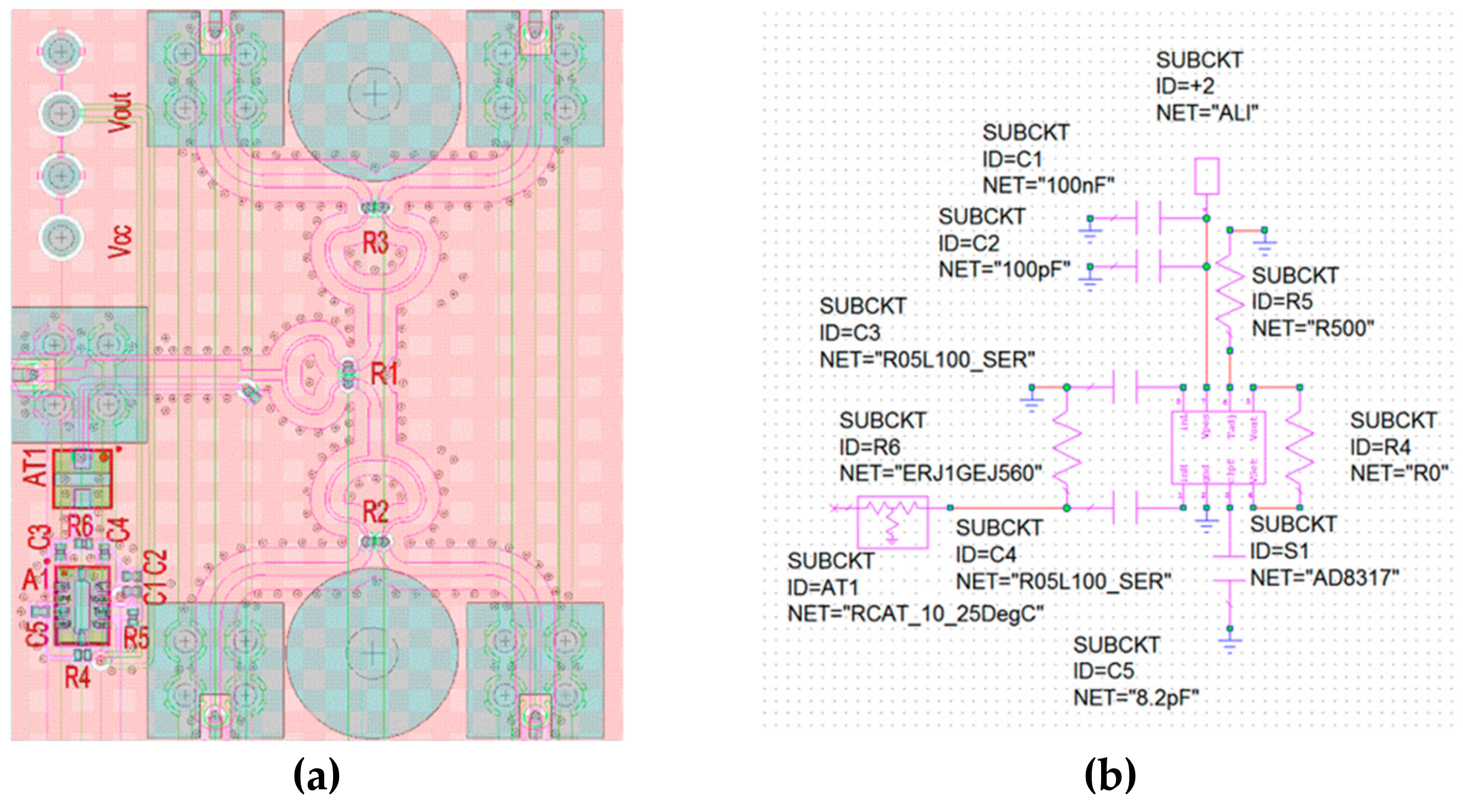
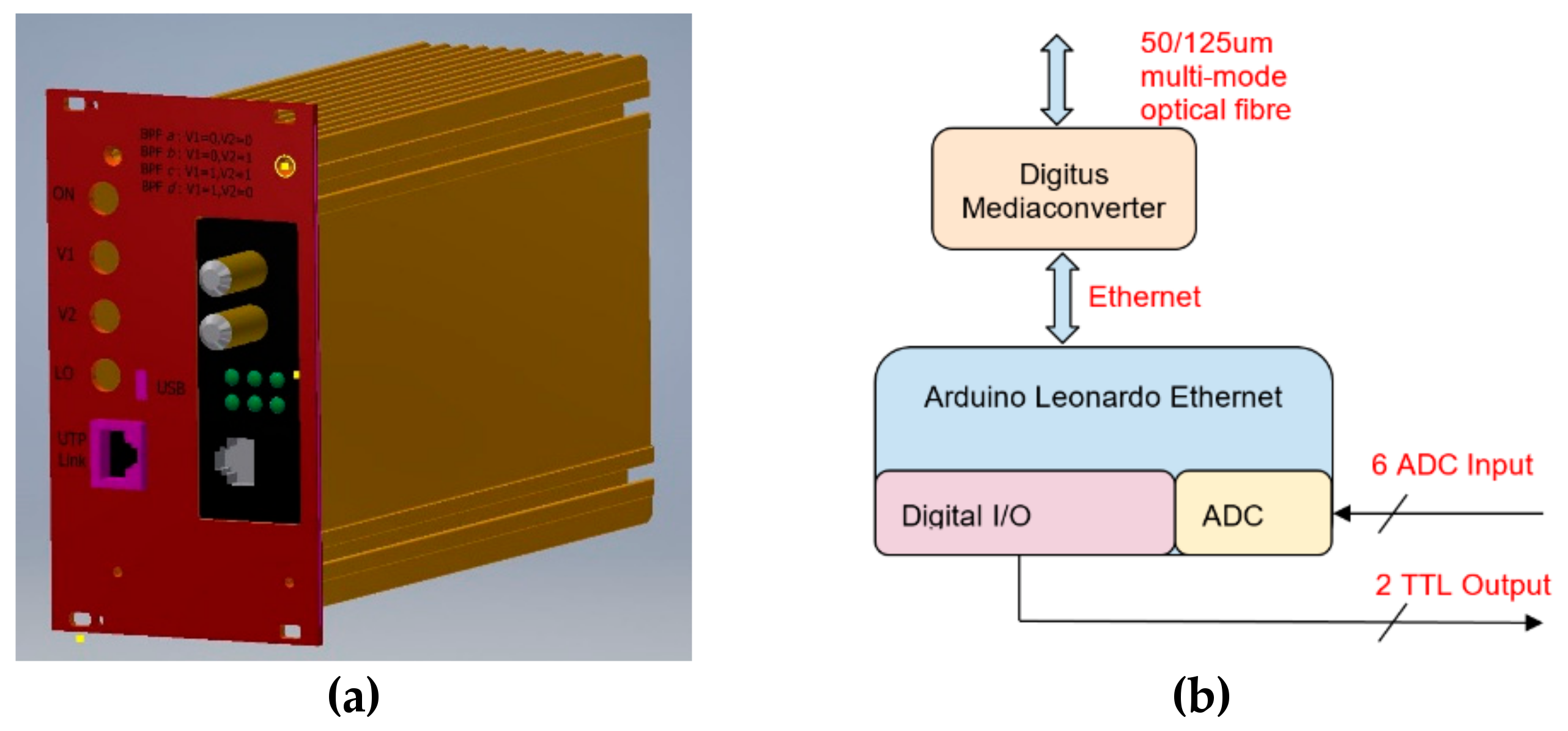
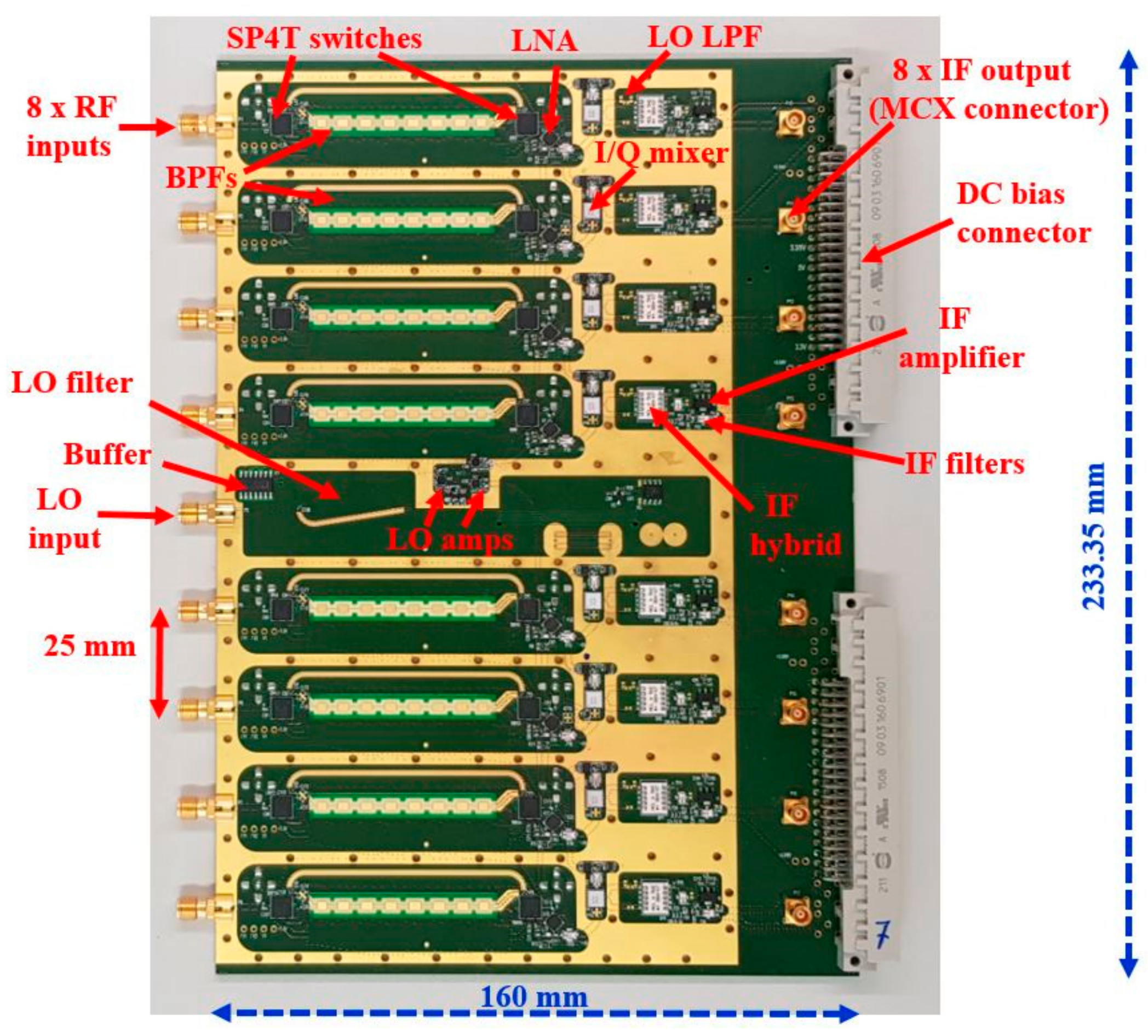
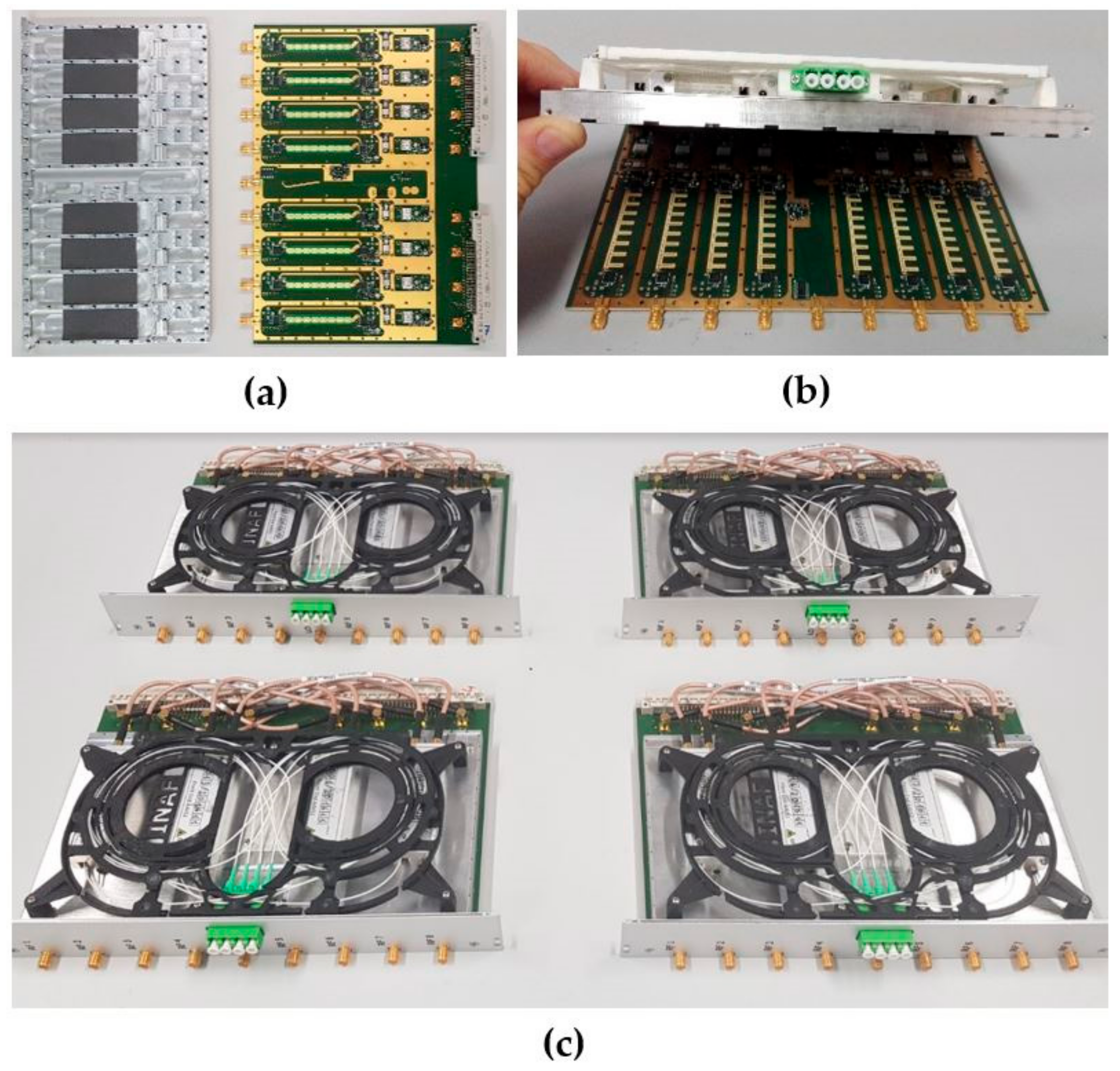
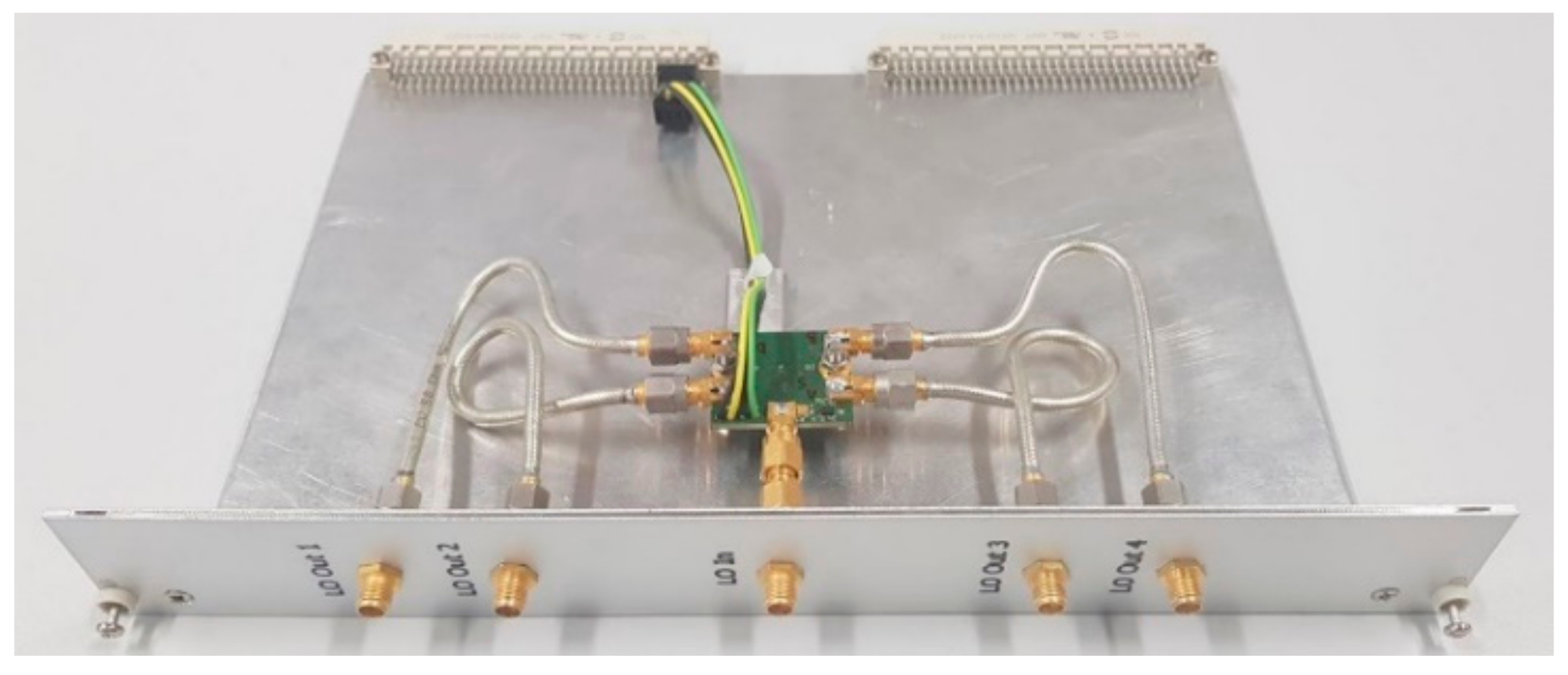
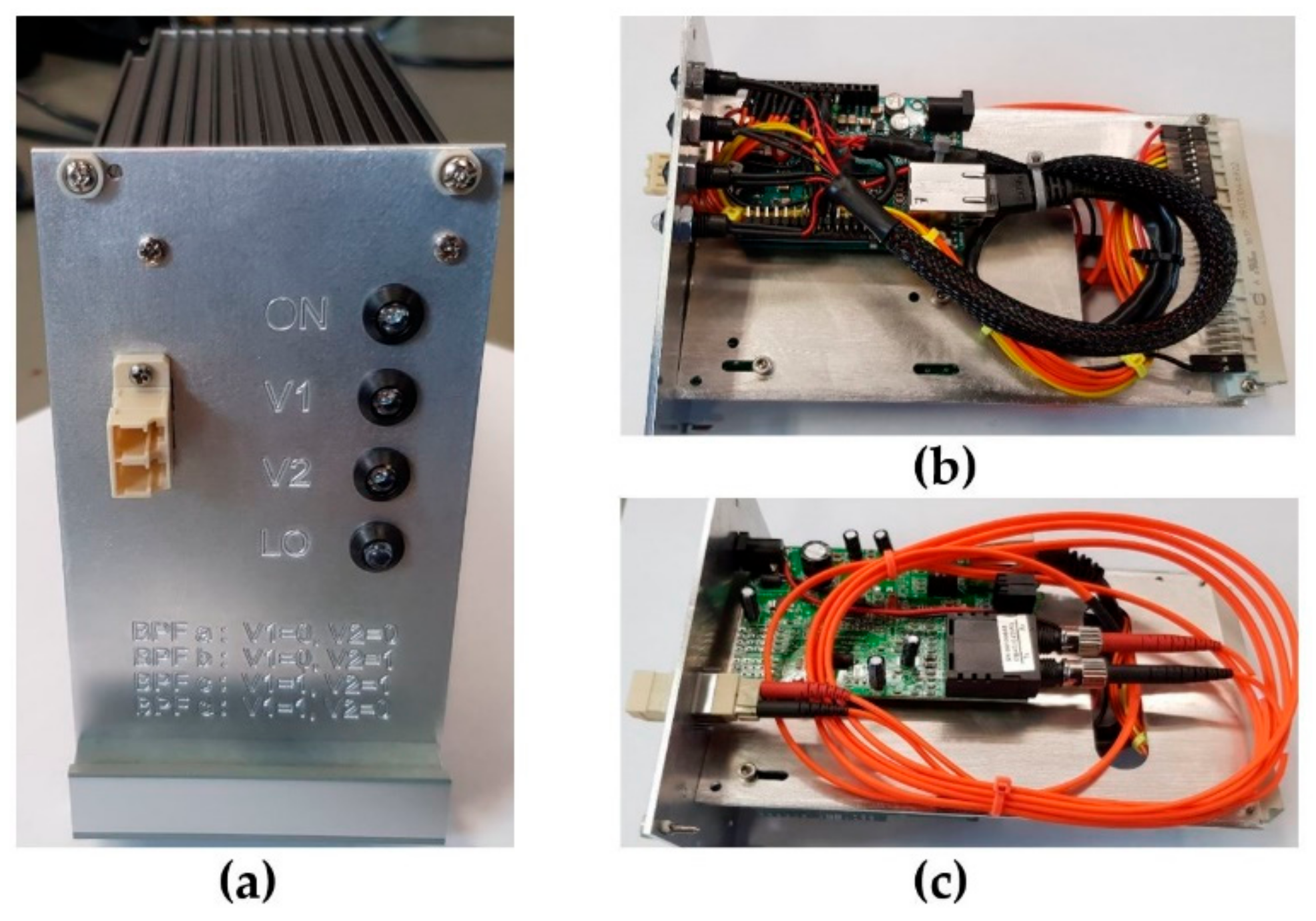
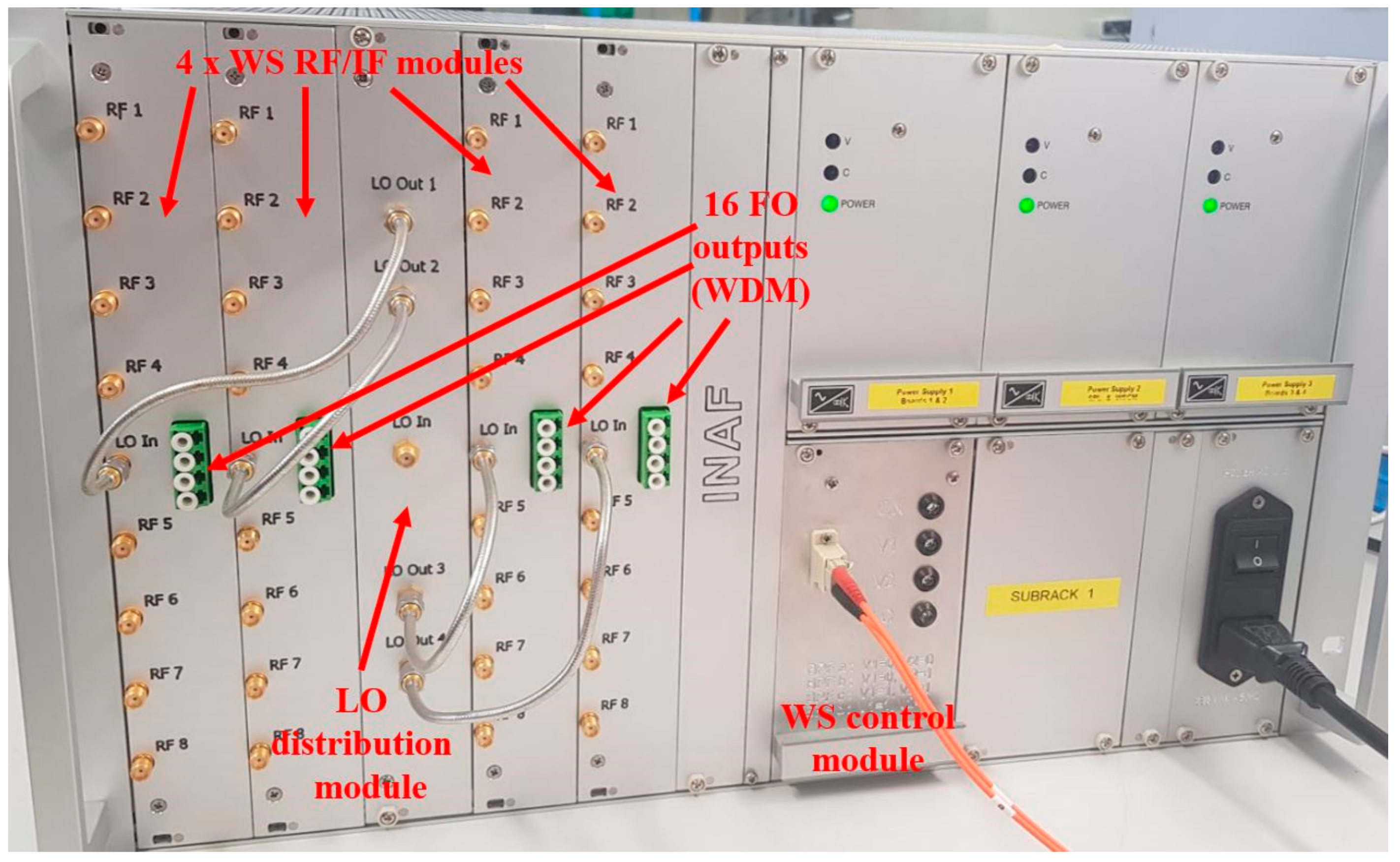
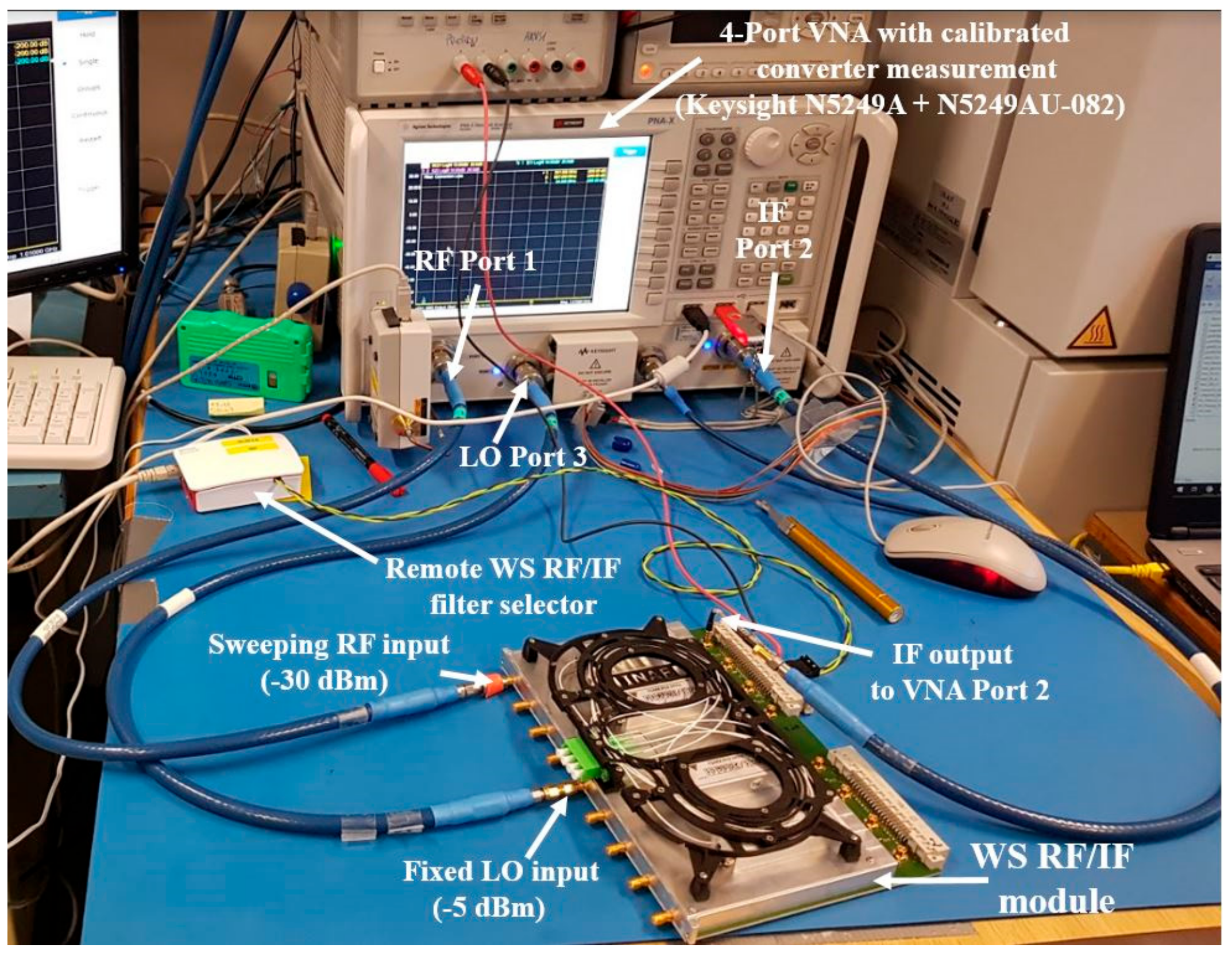
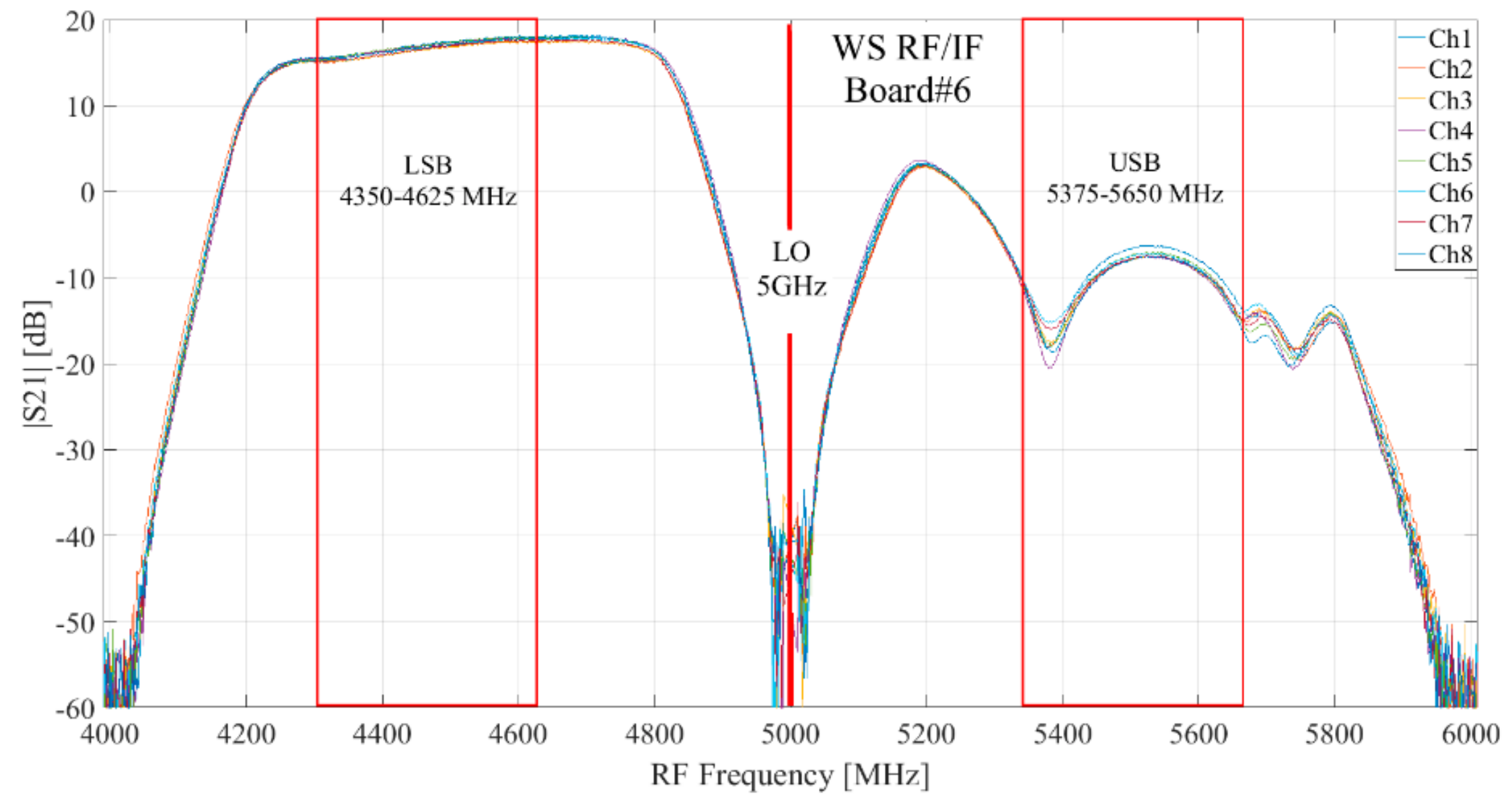

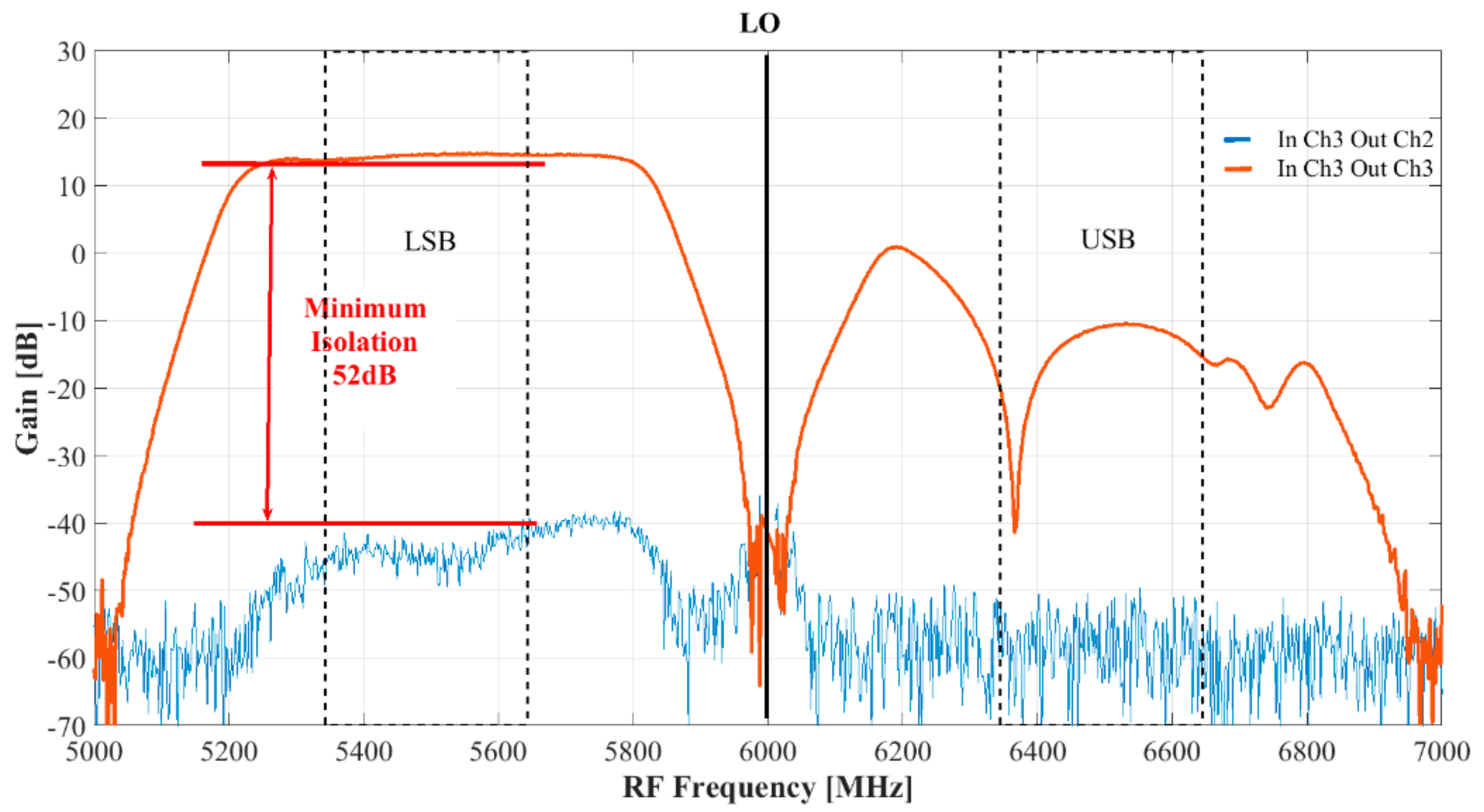
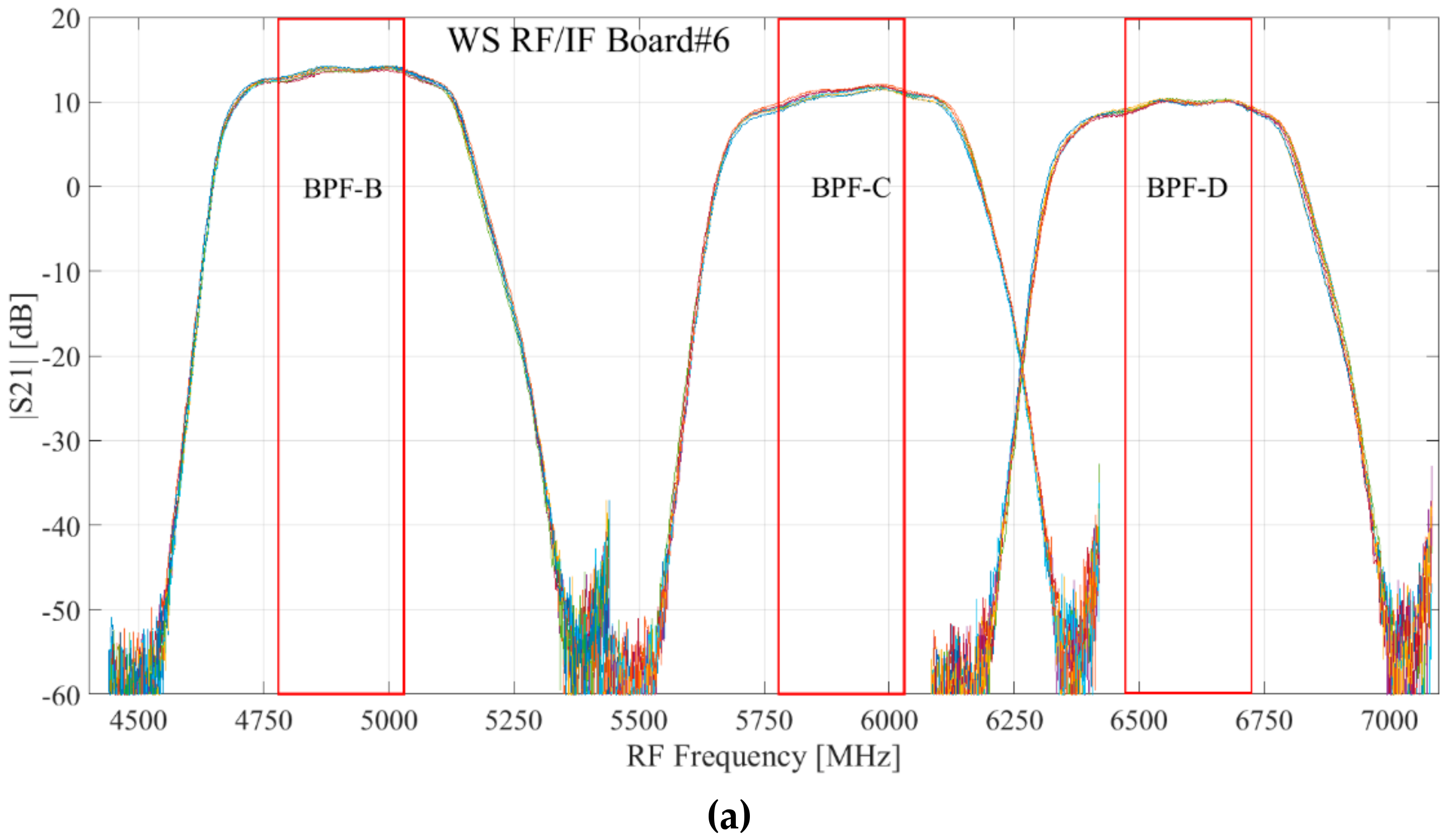
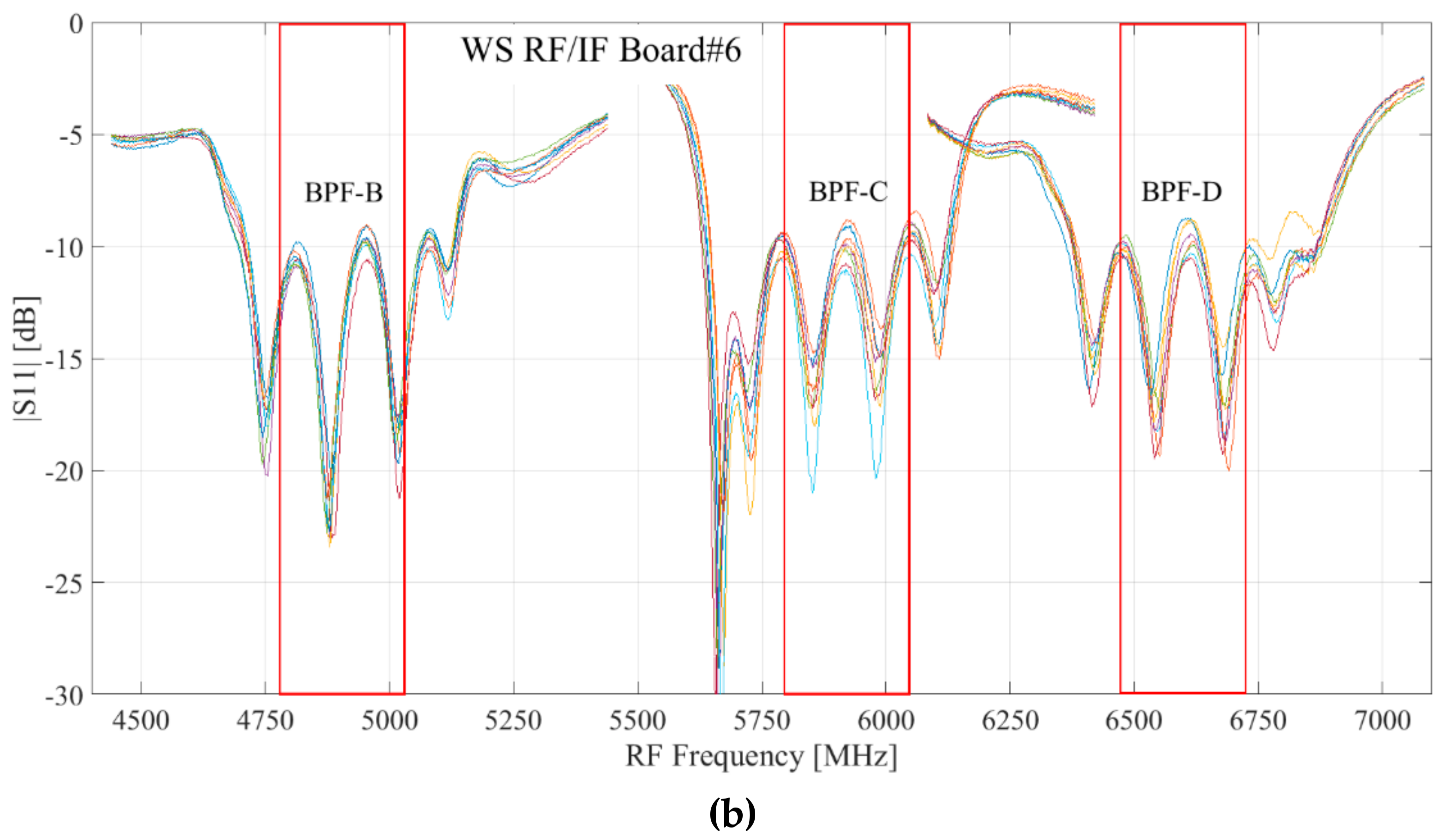
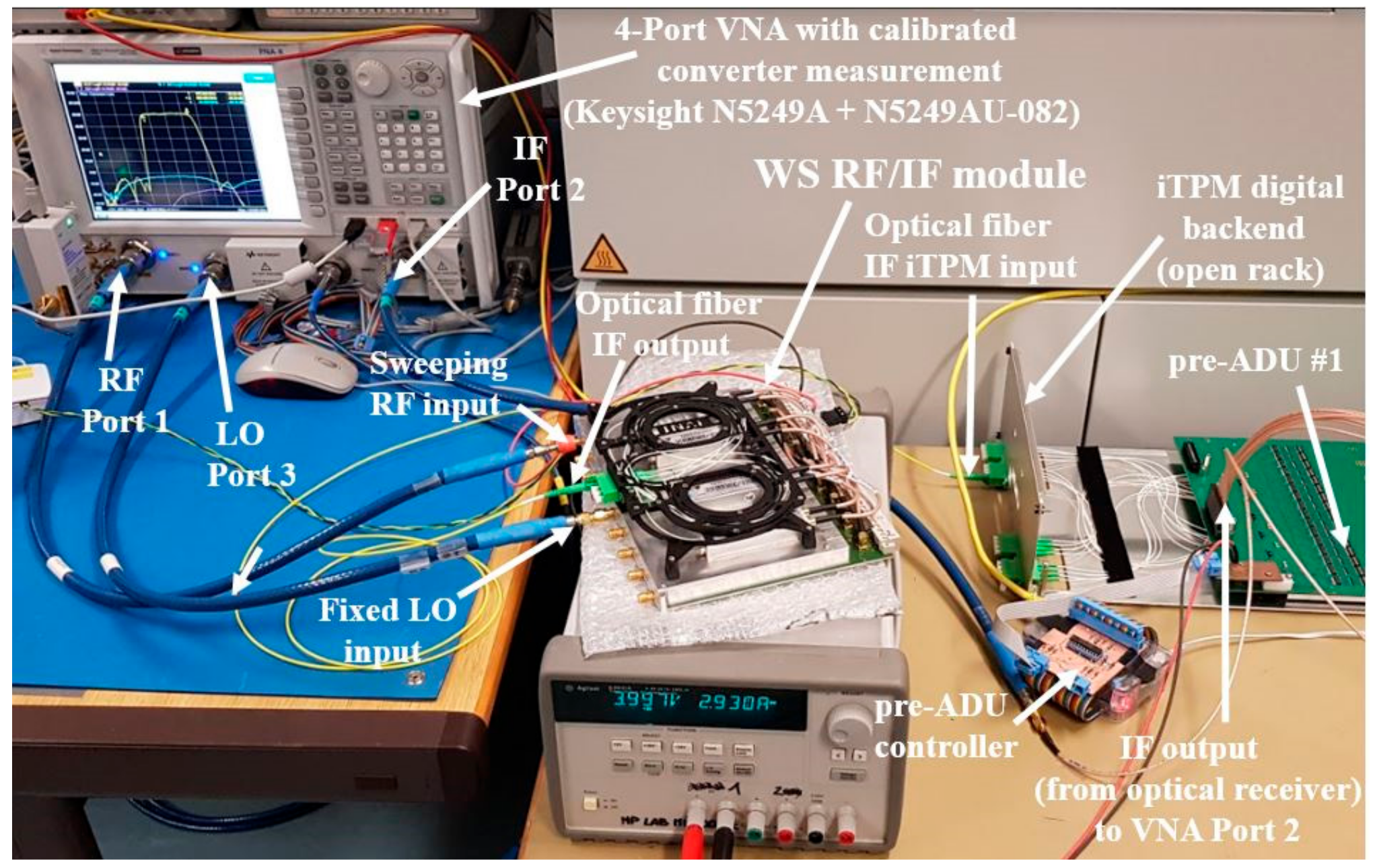
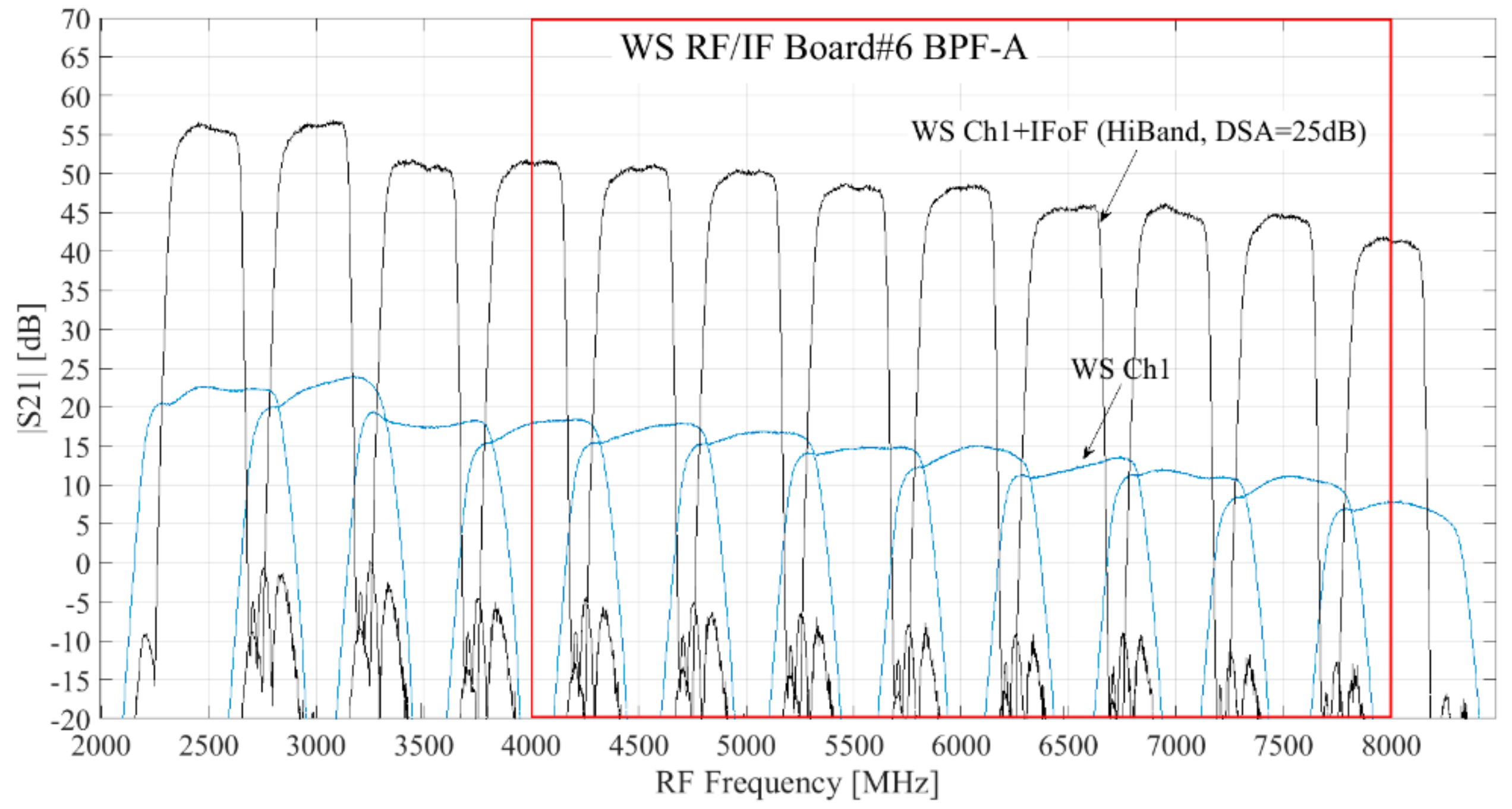
| Number of radio frequency (RF) channels | 32 (four × eight-channel RF/IF modules) |
| RF band | 2.3–8.2 GHz |
| Frequency conversion scheme | Sideband separating mixer in lower side band (LSB) (USB terminated) |
| Local oscillator (LO) band | 2.950–8.575 GHz |
| Intermediate frequency (IF) band | 375–650 MHz |
| Switched filter banks: band pass filter (BPF) frequency range and LO frequency | BPF-A: 2.300–8.200 GHz; (LO tuning fLO = 2.950–8.575 GHz) |
| BPF-B: 4.775–5.050 GHz; fLO = 5.425 GHz | |
| BPF-C: 5.780–6.055 GHz; fLO = 6.430 GHz | |
| BPF-D: 6.445–6.720 GHz; fLO = 7.095 GHz | |
| Signal transportation | Two IF output signals transported over a single optical fiber (IFoF) using WDM |
| Number of wavelength division multiplexing (WDM) fiber-optics link | 16 |
| Control module | Optical fiber-Ethernet media-converter and microcontroller for BPF selection and LO power and printed circuit board (PCB) temperature monitoring |
© 2019 by the authors. Licensee MDPI, Basel, Switzerland. This article is an open access article distributed under the terms and conditions of the Creative Commons Attribution (CC BY) license (http://creativecommons.org/licenses/by/4.0/).
Share and Cite
Navarrini, A.; Scalambra, A.; Rusticelli, S.; Maccaferri, A.; Cattani, A.; Perini, F.; Ortu, P.; Roda, J.; Marongiu, P.; Saba, A.; et al. The Room Temperature Multi-Channel Heterodyne Receiver Section of the PHAROS2 Phased Array Feed. Electronics 2019, 8, 666. https://doi.org/10.3390/electronics8060666
Navarrini A, Scalambra A, Rusticelli S, Maccaferri A, Cattani A, Perini F, Ortu P, Roda J, Marongiu P, Saba A, et al. The Room Temperature Multi-Channel Heterodyne Receiver Section of the PHAROS2 Phased Array Feed. Electronics. 2019; 8(6):666. https://doi.org/10.3390/electronics8060666
Chicago/Turabian StyleNavarrini, Alessandro, Alessandro Scalambra, Simone Rusticelli, Andrea Maccaferri, Alessandro Cattani, Federico Perini, Pierluigi Ortu, Juri Roda, Pasqualino Marongiu, Andrea Saba, and et al. 2019. "The Room Temperature Multi-Channel Heterodyne Receiver Section of the PHAROS2 Phased Array Feed" Electronics 8, no. 6: 666. https://doi.org/10.3390/electronics8060666
APA StyleNavarrini, A., Scalambra, A., Rusticelli, S., Maccaferri, A., Cattani, A., Perini, F., Ortu, P., Roda, J., Marongiu, P., Saba, A., Poloni, M., Ladu, A., & Schirru, L. (2019). The Room Temperature Multi-Channel Heterodyne Receiver Section of the PHAROS2 Phased Array Feed. Electronics, 8(6), 666. https://doi.org/10.3390/electronics8060666






